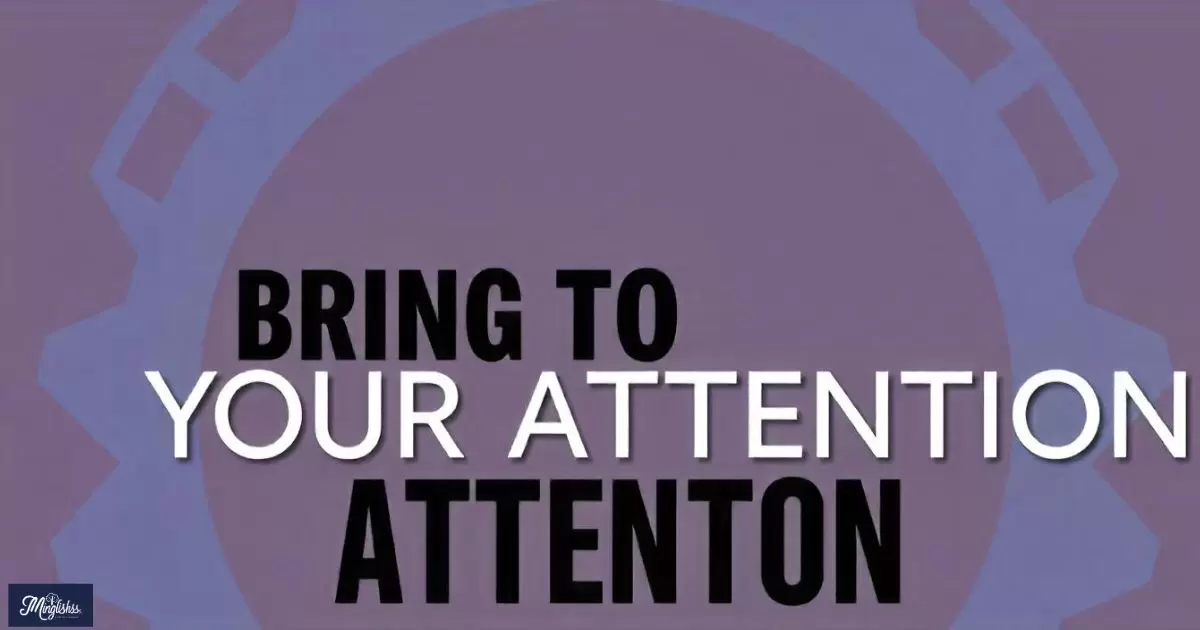“Discover the Art of Gentle Communication: Polite Alternatives to ‘Bring to Your Attention’.”
Effective communication is an essential skill in both personal and professional settings. One phrase that often comes up in formal correspondence is “bring to your attention.” While this phrase serves a clear purpose, there are numerous alternative ways to convey the same message more politely or creatively. Understanding these alternatives can enhance your communication style, making your interactions smoother and more engaging.
In today’s fast-paced world, it’s important to stand out with your communication. Whether you’re drafting an email, preparing a report, or simply having a conversation, using varied and courteous expressions can leave a positive impression. By incorporating these polite alternatives, you can ensure that your message is received well and appreciated.
In this blog, we will explore 25 different ways to say “bring to your attention.” Each suggestion will be accompanied by a practical scenario, a brief subject explanation, and additional tips to help you use these phrases effectively. By the end, you’ll be well-equipped to choose the most appropriate expression for any situation.
25 Polite Ways to Say “Bring to Your Attention”
1. “I would like to highlight”
Scenario: You’re writing a report and want to emphasize a key point to your manager.
Subject Explanation: Use this phrase to draw attention to important details in a manner that shows respect for the reader’s time. It implies that you’re presenting something noteworthy without sounding too forceful.
Additional Tip: Highlighting can be especially useful in written documents where visual emphasis might also be applied, such as bolding or underlining.
2. “I would like to draw your attention to”
Scenario: During a meeting, you need to make sure your colleague notices a specific issue.
Subject Explanation: This phrase gently directs the listener’s focus to a particular point, demonstrating that you value their attention on the matter.
Additional Tip: Pair this phrase with a brief explanation to provide context, making it easier for the recipient to understand the significance of the point.
3. “Please be aware of”
Scenario: You’re sending a reminder about an upcoming deadline.
Subject Explanation: This polite expression is a straightforward way to ensure that the recipient is cognizant of important information. It’s less about directing attention and more about ensuring awareness.
Additional Tip: Combine this phrase with a clear call to action to enhance its effectiveness.
4. “I wanted to inform you about”
Scenario: Informing your team about a change in project scope.
Subject Explanation: This approach is useful for conveying information clearly and politely. It shows that you’re providing valuable updates that could affect the recipient.
Additional Tip: Ensure that the information you are sharing is relevant and timely to maintain the recipient’s engagement.
5. “I thought you should know”
Scenario: Letting a client know about a service update.
Subject Explanation: This phrase implies that you are sharing information that might be beneficial or necessary for the recipient to know. It’s a casual yet respectful way of conveying important details.
Additional Tip: Use this phrase when you want to keep the tone friendly and approachable.
6. “I would like to make you aware”
Scenario: Notifying a colleague about a new policy.
Subject Explanation: This phrase is similar to “please be aware of,” but with a slightly more formal tone. It ensures that the recipient is conscious of important changes or updates.
Additional Tip: Use this in formal communications where clarity and formality are key.
7. “I am writing to let you know”
Scenario: Sending an email about a meeting reschedule.
Subject Explanation: This expression sets a clear purpose for the communication, indicating that you are informing the recipient about a particular matter.
Additional Tip: Be specific about the information being conveyed to avoid any confusion.
8. “I wish to bring to your notice”
Scenario: Addressing a minor issue in a project update.
Subject Explanation: This formal phrase is suitable for official documents or communications where professionalism is crucial. It signals that you are drawing attention to something of importance.
Additional Tip: This phrase is best used in written correspondence where a formal tone is required.
9. “I would like to point out”
Scenario: Highlighting a discrepancy in a report.
Subject Explanation: This phrase is effective for emphasizing a specific issue or detail that requires attention. It’s direct yet polite, making it suitable for various contexts.
Additional Tip: Use this phrase to clearly indicate what needs to be addressed or corrected.
10. “May I direct your attention to”
Scenario: Suggesting a key detail during a presentation.
Subject Explanation: This phrase is particularly useful when you want to guide someone’s focus towards something significant in a respectful manner.
Additional Tip: This can be paired with visual aids or references to strengthen your point.
11. “I would like to point out”
Scenario: Notifying a team about an important observation.
Subject Explanation: This approach is a straightforward way to draw attention to a particular aspect of your message or work, ensuring it doesn’t go unnoticed.
Additional Tip: Keep your explanation concise to maintain the recipient’s focus.
12. “Please consider”

Scenario: Requesting feedback on a proposal.
Subject Explanation: This phrase invites the recipient to give thoughtful consideration to the information or request you are presenting. It’s a polite way to seek their input.
Additional Tip: Use this phrase when you want to encourage reflection and response.
13. “I would like to bring to your consideration”
Scenario: Proposing a new strategy during a planning session.
Subject Explanation: This expression is a formal way of suggesting that the recipient give thoughtful consideration to your proposal or idea.
Additional Tip: Ensure that your proposal is well-prepared to facilitate positive consideration.
14. “I wish to draw your attention to”
Scenario: Notifying a supervisor about a critical issue.
Subject Explanation: This formal expression emphasizes the importance of a particular matter, ensuring it gets the necessary attention.
Additional Tip: This phrase is effective in formal reports or communications where detailed attention is required.
15. “I would like to remind you”
Scenario: Sending a follow-up email about an upcoming meeting.
Subject Explanation: Use this phrase to gently remind someone about something important without sounding demanding.
Additional Tip: Be courteous and brief to ensure the reminder is well-received.
16. “It’s important to note”
Scenario: Highlighting a key finding in a research paper.
Subject Explanation: This phrase emphasizes the significance of a particular point, making sure it stands out to the reader.
Additional Tip: Combine this phrase with specific details to enhance clarity and impact.
17. “I’d like to make you aware of”
Scenario: Informing a client about a change in terms.
Subject Explanation: This polite expression is suitable for making sure the recipient is aware of important information without being too assertive.
Additional Tip: Use this phrase when providing updates or changes that could affect the recipient.
18. “I want to bring to your attention”
Scenario: Addressing a concern in a team meeting.
Subject Explanation: This direct approach is useful for clearly presenting an issue or important detail that requires immediate attention.
Additional Tip: Use this phrase to ensure the recipient understands the urgency or importance of the matter.
19. “I would like to draw your focus to”
Scenario: Pointing out a specific detail in a document review.
Subject Explanation: This phrase guides the recipient’s attention to a particular detail that may be critical for understanding or decision-making.
Additional Tip: Use this when you need to ensure that a specific point is thoroughly reviewed.
20. “I am reaching out to highlight”
Scenario: Bringing up an issue in a client service report.
Subject Explanation: This informal yet respectful phrase can be used to ensure that important details are not overlooked.
Additional Tip: It’s effective in casual or semi-formal communication where a personal touch is appreciated.
Professional Ways to Say “No Worries”
21. “I wish to bring to your attention”
Scenario: Alerting a colleague to a potential problem with a project.
Subject Explanation: This formal expression ensures that the recipient is aware of a critical issue, making it suitable for professional contexts.
Additional Tip: Make sure to provide context or suggestions to address the issue effectively.
22. “I wanted to make you aware”
Scenario: Informing a team member about an upcoming deadline.
Subject Explanation: This phrase is a gentle way of making someone aware of important information or deadlines, maintaining a polite tone.
Additional Tip: Pair this with a clear timeline or next steps for added clarity.
23. “I’d like to highlight”

Scenario: Drawing attention to a particular success in a project report.
Subject Explanation: This phrase emphasizes positive aspects or achievements, making it useful for recognition or praise.
Additional Tip: Use this to showcase important successes or key points that deserve attention.
24. “I would like to bring to your notice”
Scenario: Addressing a compliance issue in a formal letter.
Subject Explanation: This formal phrase is ideal for professional communications where attention to detail is crucial.
Additional Tip: Ensure that your notice is accompanied by relevant details or instructions.
25. “I am writing to draw your attention to”
Scenario: Alerting a business partner about a contract amendment.
Subject Explanation: This phrase clearly communicates that you are bringing something important to the recipient’s attention, maintaining professionalism.
Additional Tip: This phrase is best used in formal written communications to ensure clarity and respect.
Additional Tips and Insights
Tips for Effective Communication:
- Know Your Audience: Tailor your expression based on whether your communication is formal or informal. For professional settings, more formal phrases are appropriate, while casual interactions can use more relaxed expressions.
- Be Clear and Concise: Regardless of the phrase you choose, ensure your message is clear and to the point. Avoid unnecessary jargon and provide context where needed.
- Pair with Action: When drawing attention to something important, suggest actionable steps or provide additional information to support your point.
- Maintain a Polite Tone: Always use polite language to convey respect and consideration for the recipient’s time and attention.
Pros and Cons
Pros
- Variety in Communication: Using different phrases can make your communication more engaging and effective.
- Enhanced Professionalism: Polite alternatives reflect well on your communication style, particularly in formal settings.
- Improved Relationships: Courteous expressions can strengthen relationships by demonstrating respect and consideration.
Cons
- Potential Confusion: Too many alternatives might confuse the recipient if not used appropriately.
- Formality vs. Informality: Choosing the wrong level of formality can impact the effectiveness of your communication.
Conclusion
Incorporating polite ways to say “bring to your attention” can greatly enhance your communication skills. By using these varied expressions, you can ensure that your messages are received positively and effectively. Whether in professional emails, meetings, or casual conversations, these phrases help you convey your points respectfully and clearly.
Remember to choose the most appropriate expression for your context and always aim for clarity and politeness in your communication.

Hi, I’m Zadie Smith: I’m dedicated to helping others master English through practical tips. I enjoy making complex ideas simple and accessible for everyone.










